overheating CHEVROLET CAVALIER 1995 3.G Owners Manual
[x] Cancel search | Manufacturer: CHEVROLET, Model Year: 1995, Model line: CAVALIER, Model: CHEVROLET CAVALIER 1995 3.GPages: 340, PDF Size: 17.09 MB
Page 3 of 340
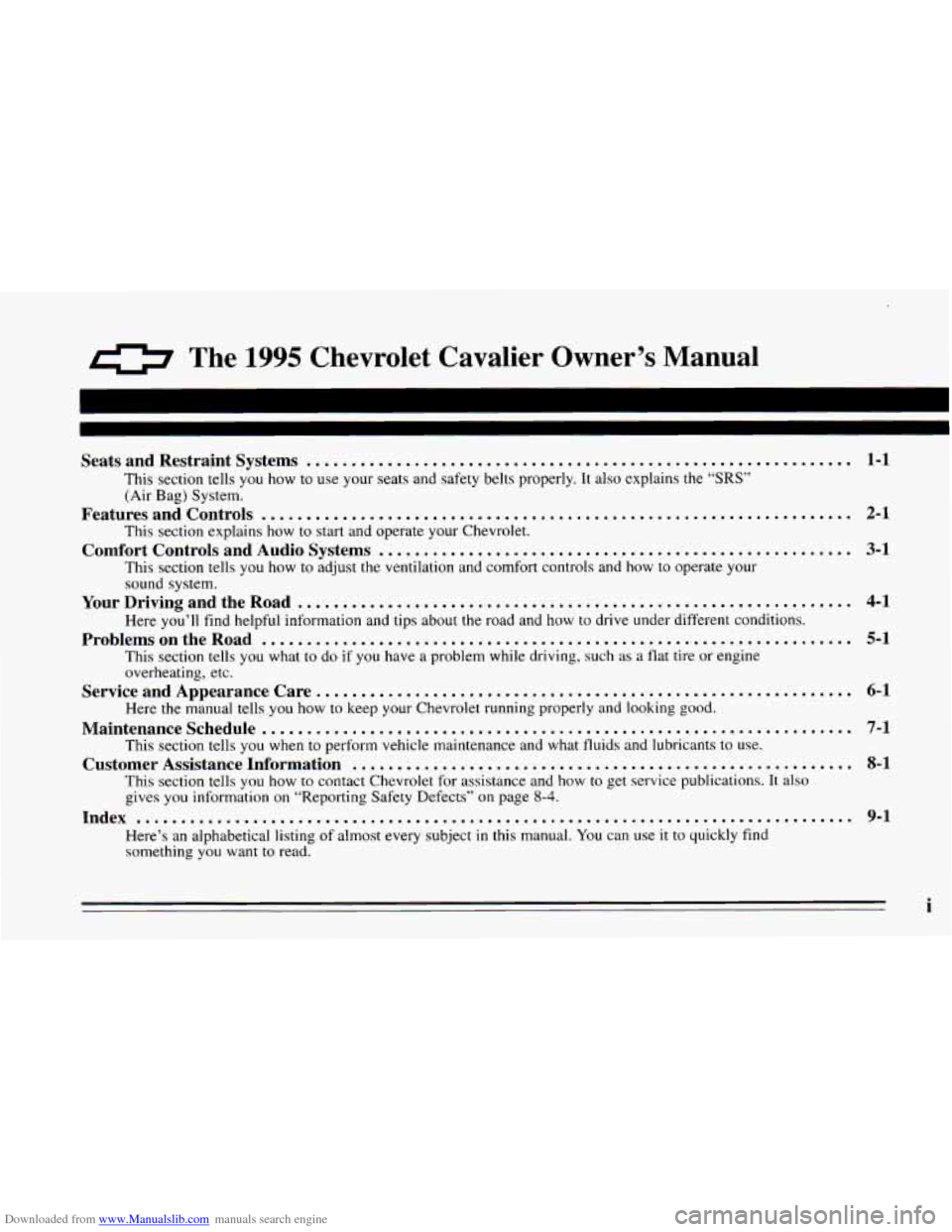
Downloaded from www.Manualslib.com manuals search engine 0 TI-? 1995 Chevrolet Cavalier Owner’s Manual
I
Seats and Restraint Systems .............................................................
This section tells you how to use your seats and safety belts properly. It also explains the “SRS”
(Air Bag) System.
This section explains how to start and operate your Chevrolet.
This section tells you how to adjust the ventilation and comfort controls and how to operate your
sound system.
YourDrivingandtheRoad ..............................................................
Here you’ll find helpful information and tips about the road and how to drive under different conditions.
ProblemsontheRoad ..................................................................
This section tells you what to do if you have a problem while driving, such as a flat tire or engine
overheating, etc.
ServiceandAppearanceCare ............................................................
Here the manual tells you how to keep your Chevrolet running properly and looking good.
Maintenanceschedule ..................................................................
This section tells you when to perform vehicle maintenance and what fluids and lubricants to use.
Customer Assistance Information ........................................................
This section tells you how to contact Chevrolet for assistance and how to get service publications. It also
gives
you information on “Reporting Safety Defects” on page 8-4.
Here’s an alphabetical listing of almost every subject in this manual. You can use it to quickly find
something
you want to read.
FeaturesandControls ..................................................................
Comfort Controls and Audio Systems .....................................................
Index ........................................................................\
........
1-1
2-1
3-1
4- 1
5- 1
6-1
7-1
8-1
9- 1
i
Page 120 of 340
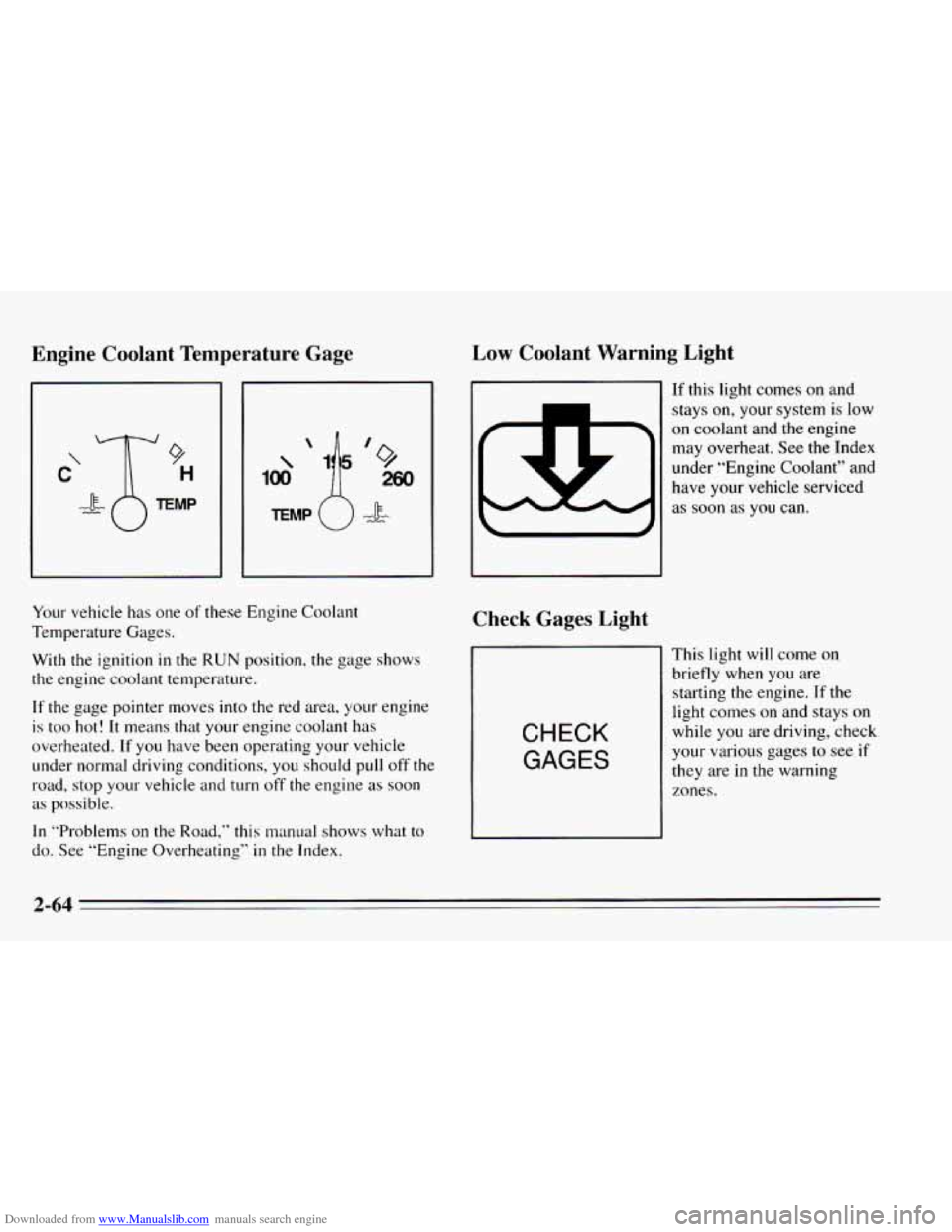
Downloaded from www.Manualslib.com manuals search engine Engine Coolant Temperature Gage
100 \‘+’” 260
Your vehicle has one of these Engine Coolant
Temperature Gages.
With the ignition
in the RUN position, the gage shows
the engine coolant temperature.
If the gage pointer tnoves into the red area, your engine
is too
hot! It means that your engine coolant has
overheated.
If you have been operating your vehicle
under normal driving conditions, you should pull
off’ the
road, stop your vehicle and turn
off’ the engine as soon
as possible.
In “Problems on the Road,“ this manual shows what to
do. See “Engine Overheating”
in the Index.
Low Coolant Warning Light
Check Gages Light
CHECK
GAGES
If this light comes on and
stays on, your system is low
on coolant and the engine
may overheat. See the Index
under “Engine Coolant” and
have your vehicle serviced
as soon as you can.
This light will come on
briefly when
you are
starting the engine.
If the
light comes on and stays
on
while you are driving, check
your various gages
to see if
they are in the warning
I
zones.
2-64
Page 175 of 340
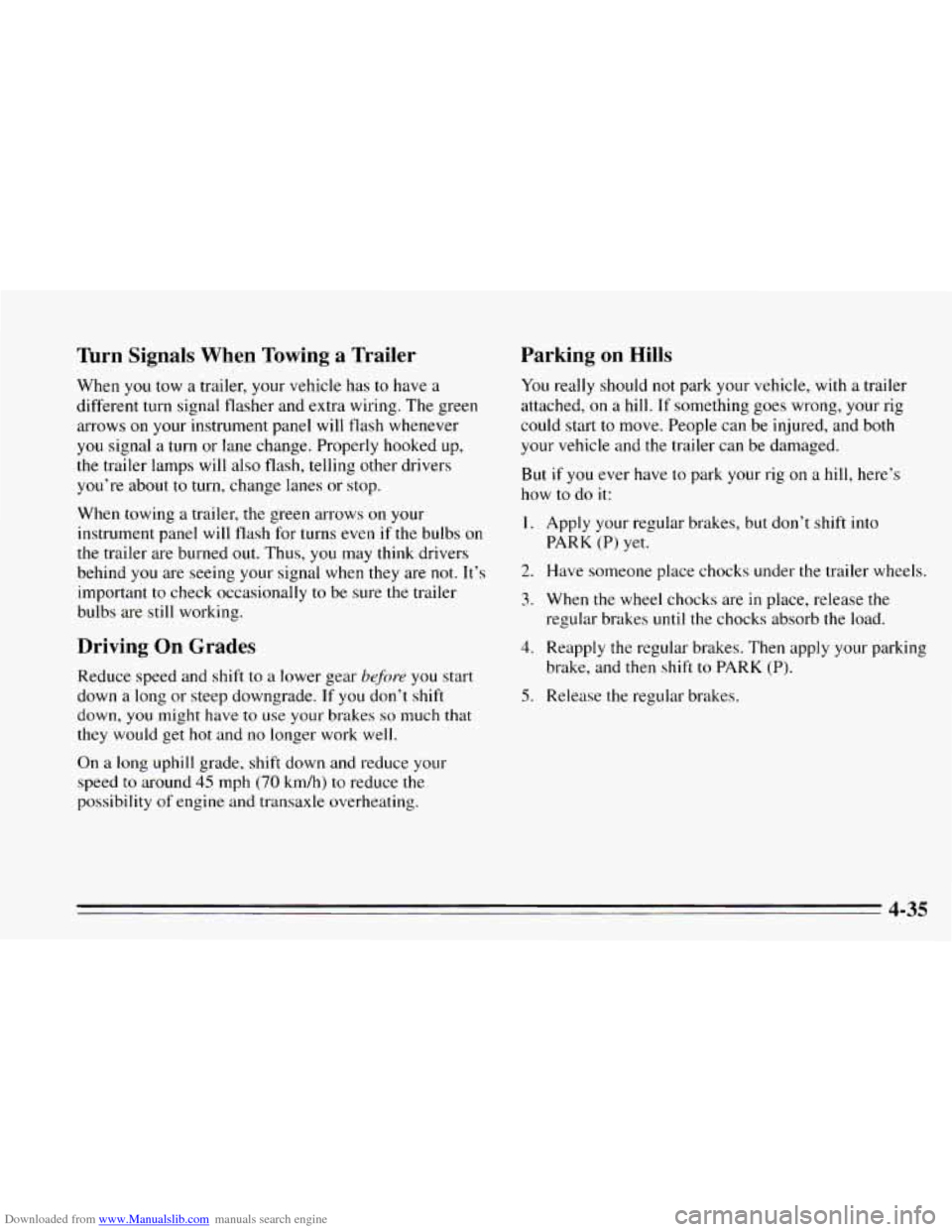
Downloaded from www.Manualslib.com manuals search engine Turn Signals When Towing a Trailer
When you tow a trailer, your vehicle has to have a
different turn signal flasher and extra wiring. The green
arrows on your instrument panel will flash whenever
you signal a turn or lane change. Properly hooked up,
the trailer lamps will also flash, telling other drivers
you‘re about
to turn, change lanes or stop.
When towing a trailer, the green arrows on
your
instrument panel will flash for turns even if the bulbs on
the trailer are burned out. Thus, you may think drivers
behind
you are seeing your signal when they are not. It’s
important
to check occasionally to be sure the trailer
bulbs are
still working.
Driving On Grades
Reduce speed and shift to a lower gear lwfot-e you start
down
a long or steep downgrade. If you don’t shift
down, you might have to use your brakes so much that
they would get hot and no longer work well.
On a long uphill grade, shift down and reduce your
speed
to around 45 mph (70 km/h) to reduce the
possibility of engine and transaxle overheating.
Parking on Hills
You really should not park your vehicle, with a trailer
attached,
on a hill. If something goes wrong, your rig
could start
to move. People can be injured, and both
your vehicle and
the trailer can be damaged.
But if you ever have to park your rig on a hill, here’s
how to do
it:
1. Apply your regular brakes, but don’t shift into
PARK (P) yet.
2. Have someone place chocks under the trailer wheels.
3. When the wheel chocks are in place, release the
regular brakes
until the chocks absorb the load.
4. Reapply the regular brakes. Then apply your parking
brake, and then shift
to PARK (P).
5. Release the regular brakes.
4-35
Page 188 of 340
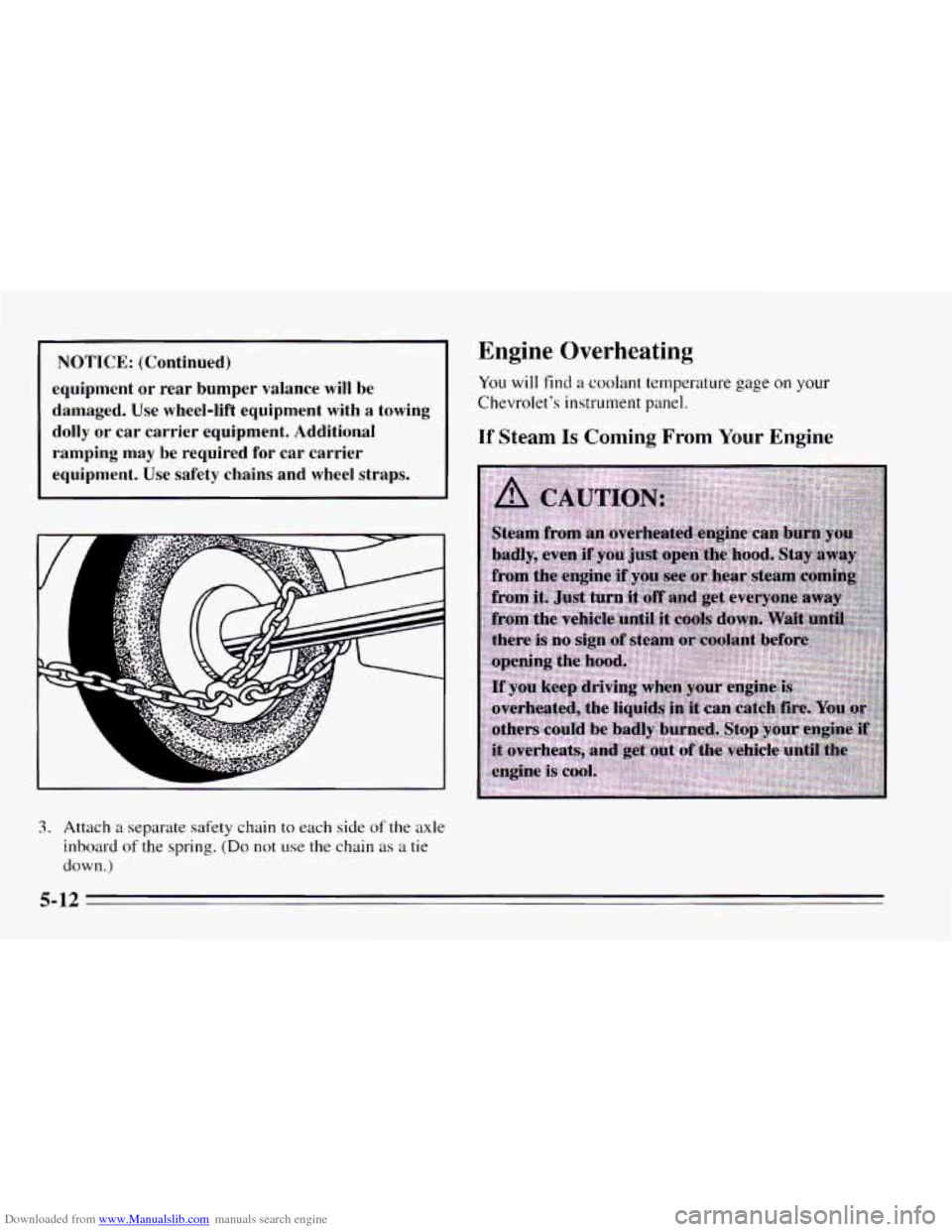
Downloaded from www.Manualslib.com manuals search engine NOTICE: (Continued)
equipment
or rear bumper valance will be
damaged. Use wheel-lift equipment with a towing
dolly or car carrier equipment. Additional
ramping may be required
for car carrier
equipment. Use safety chains and wheel straps.
Engine Overheating
You will find a coolant temperature gage on your
Chevrolet’s instrument
panel.
If Steam Is Coming From Your Engine
I I
3. Attach a separate safety chain to each side of the axle
inboard
of the spring. (Do not use the chain as a tie
down.)
5-12
Page 191 of 340
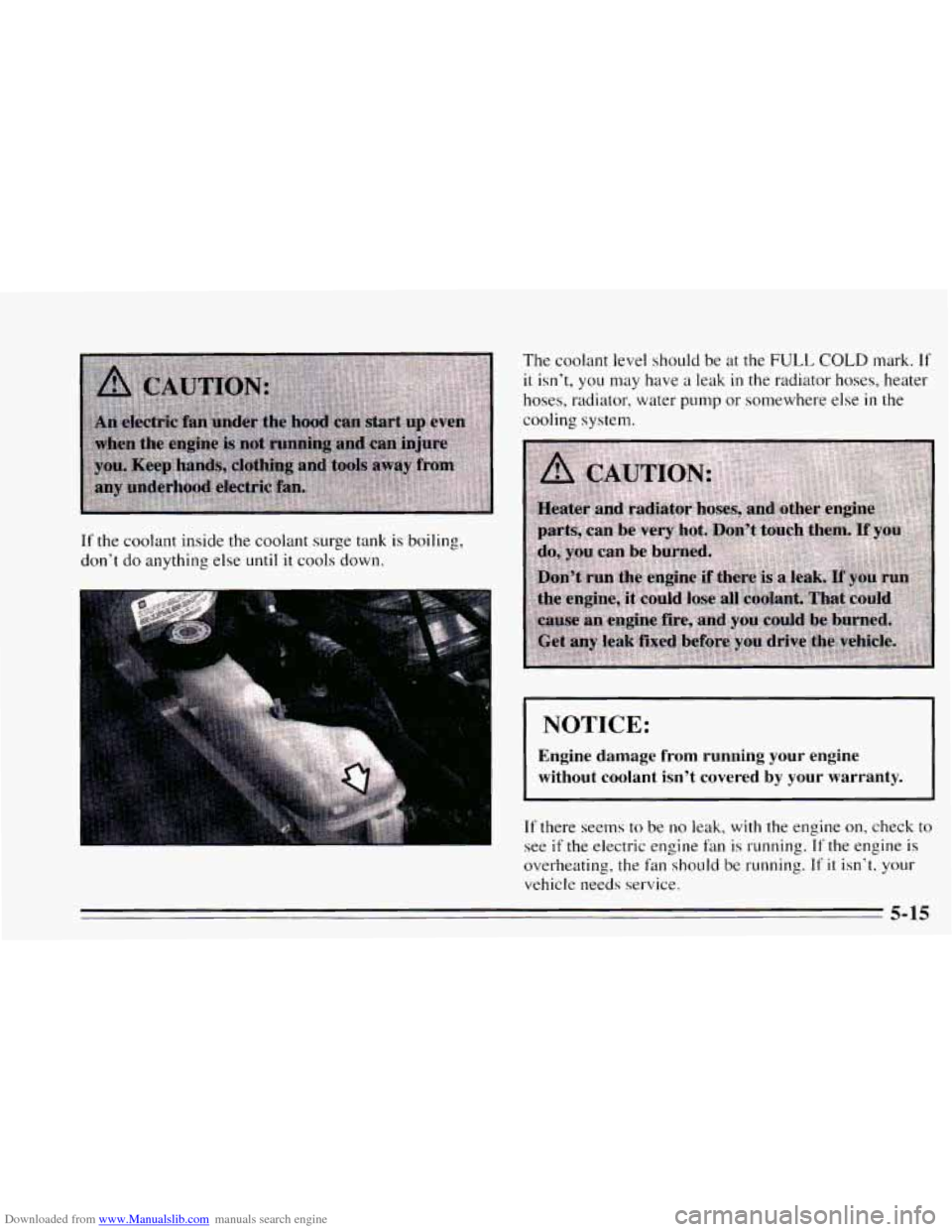
Downloaded from www.Manualslib.com manuals search engine If the coolant inside the coolant surge tank is boiling,
don't do anything else
until it cools down.
I
The coolant level should be at the FULL COLD mark. If
it isn't, you may have a leak in the radiator hoses, heater
hoses, radiator, water
pump or somewhere else in the
cooling system.
I NOTICE:
I
Engine damage from running your engine
without coolant isn't covered by your warranty.
If there seems to be no leak, with the engine on, check to
see
if the electric engine fm is running. If the engine is
overheating, the
fan should be running. If it isn't, your
vehicle needs service.
5-15
Page 225 of 340
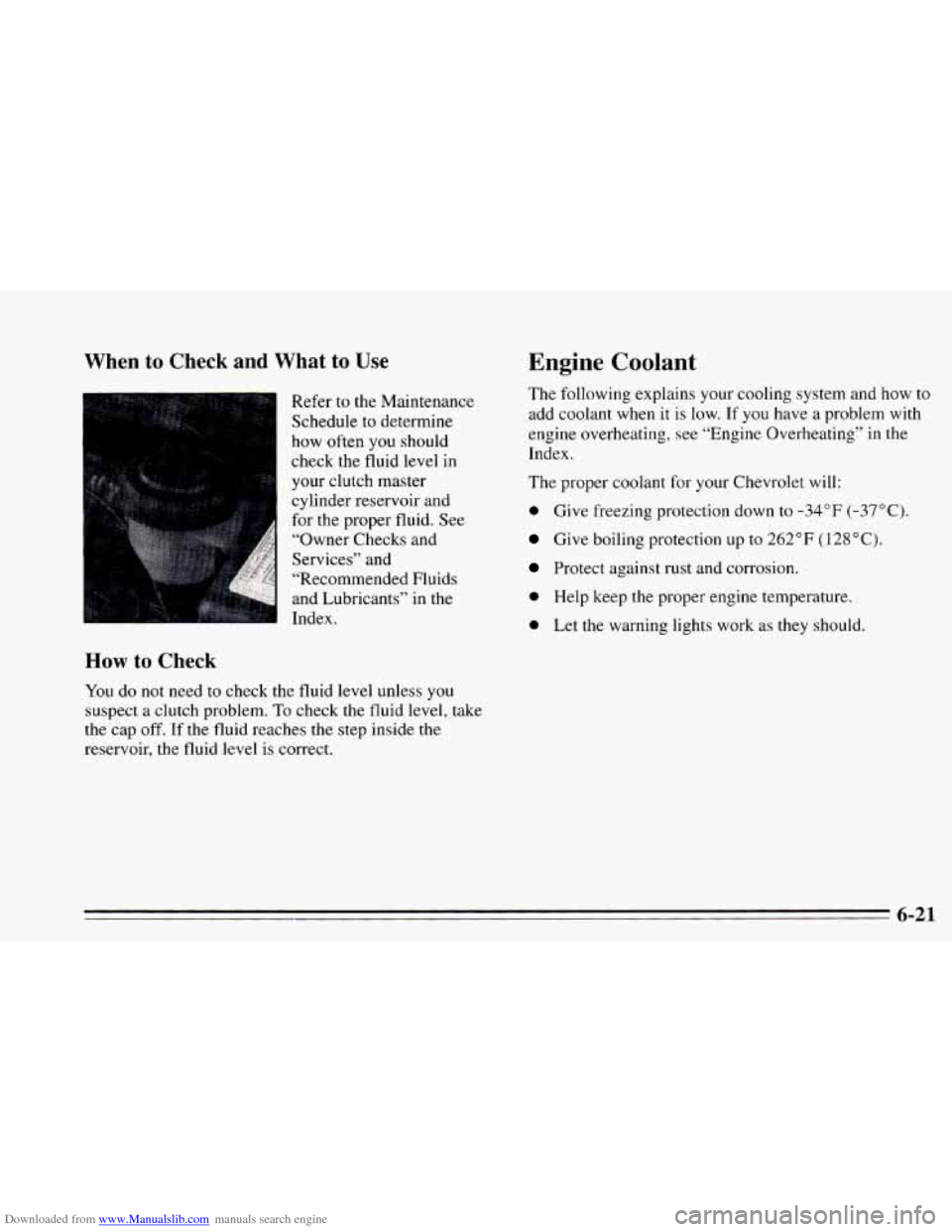
Downloaded from www.Manualslib.com manuals search engine When to Check and What to Use
Refer to the Maintenance
Schedule to determine
how often you should
check the fluid level in
your clutch master
cylinder reservoir and
for the proper fluid. See
“Owner Checks and
Services” and
“Recommended Fluids
and Lubricants” in the
Index.
How to Check
You do not need to check the fluid level unless you
suspect a clutch problem. To check the fluid level, take
the cap
off. If the fluid reaches the step inside the
reservoir, the fluid level
is correct.
Engine Coolant
The following explains your cooling system and how to
add coolant when it is low.
If you have a problem with
engine overheating, see “Engine Overheating” in the
Index.
The proper
coolant for your Chevrolet will:
0 Give freezing protection down to -34°F (-37°C).
Give boiling protection up to 262°F (128°C).
Protect against rust and corrosion.
0 Help keep the proper engine temperature.
0 Let the warning lights work as they should.
6-21
Page 227 of 340
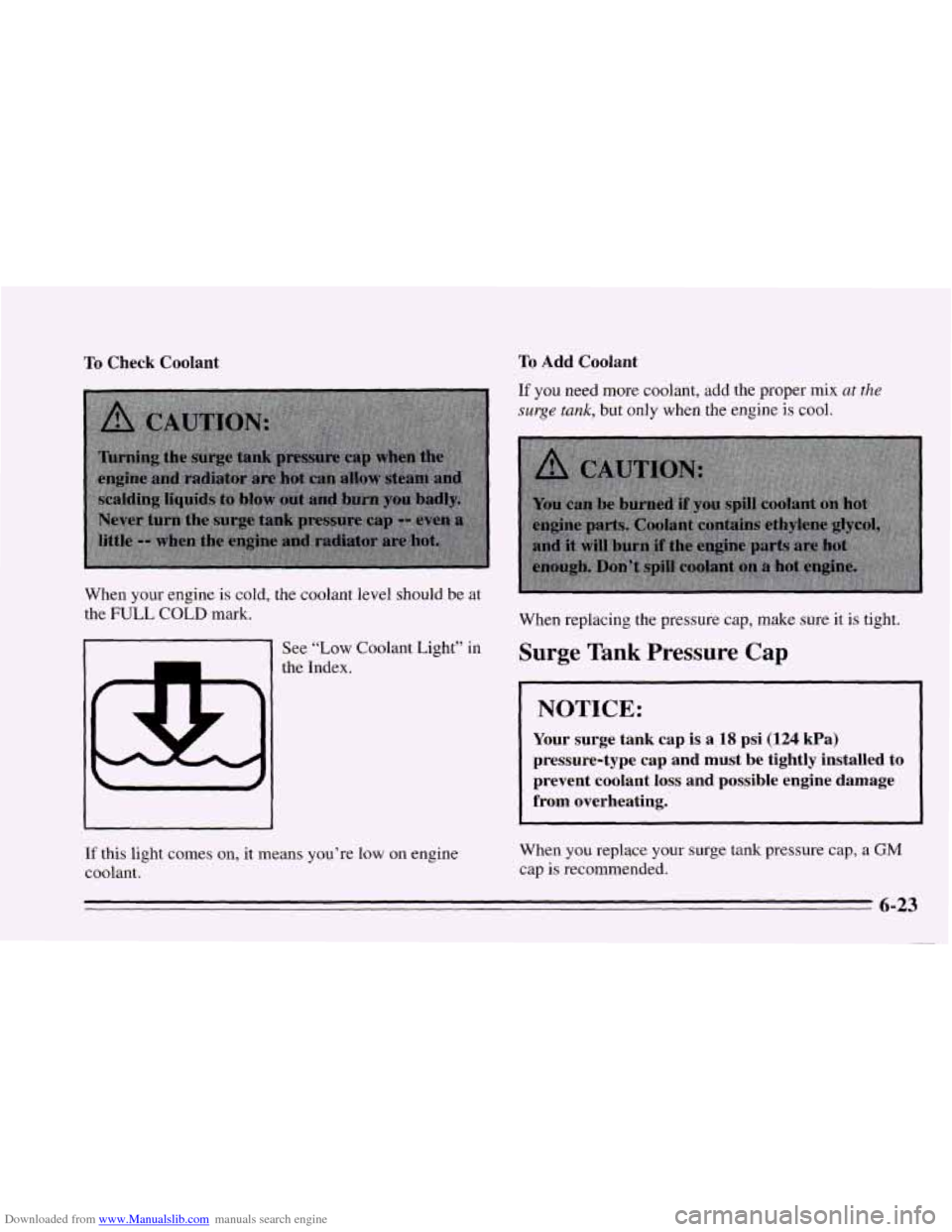
Downloaded from www.Manualslib.com manuals search engine To Check Coolant To Add Coolant
If you need more coolant, add the proper mix at the
surge tank, but only when the engine is cool.
When your engine is cold, the coolant level should be at
the FULL
COLD mark.
See “Low Coolant Light”
in
the Index. When replacing
the pressure
cap, make sure it is tight.
Surge Tank Pressure Cap
NOTICE:
Your surge tank cap is a 18 psi (124 kPa)
pressure-type cap and must be tightly installed to
prevent coolant loss and possible engine damage
from overheating.
If this light comes on, it means you’re low on engine
coolant. When
you replace your surge tank pressure cap, a GM
cap is recommended.
Page 330 of 340
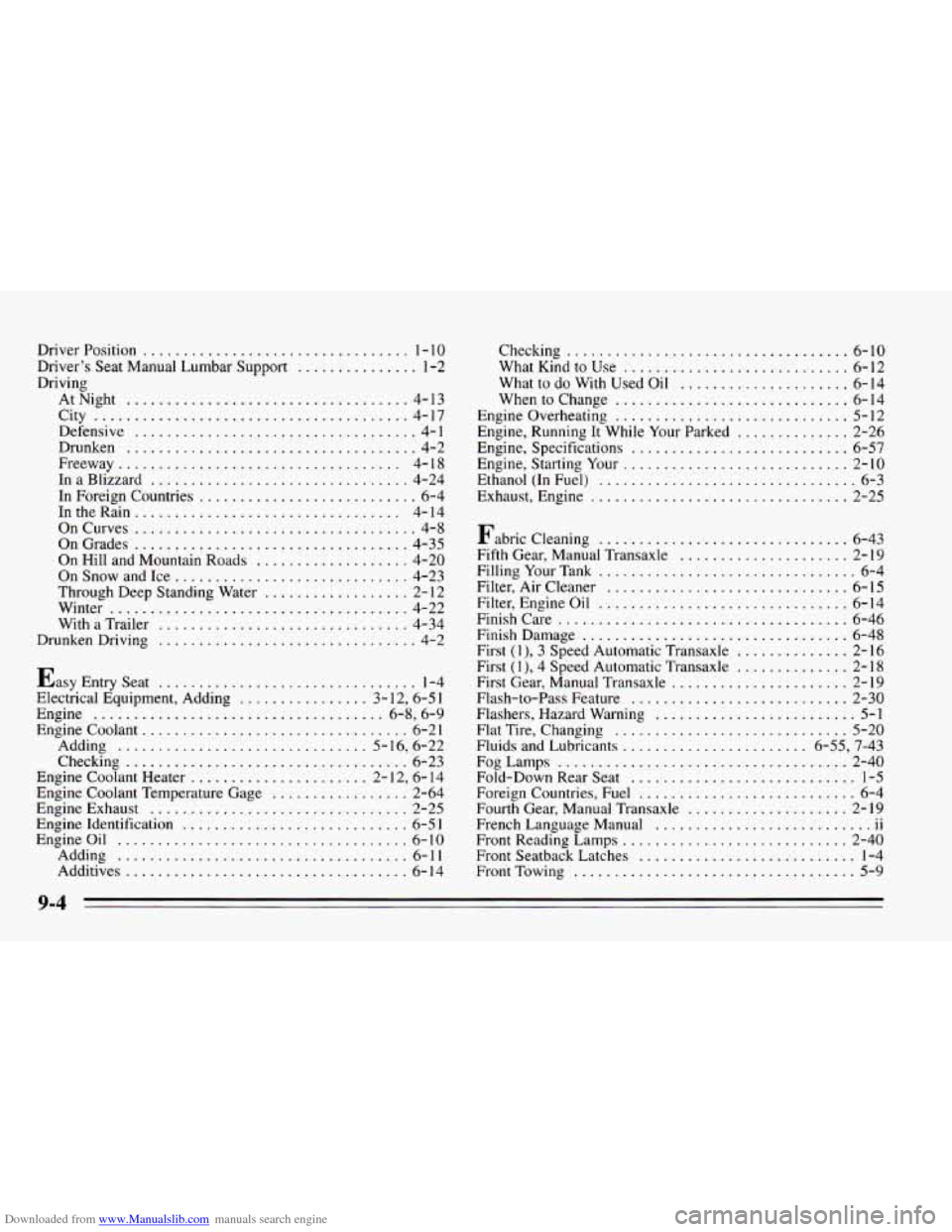
Downloaded from www.Manualslib.com manuals search engine Driver Position ................................. 1 - 10
Driver’s Seat Manual Lumbar Support ............... 1-2
Driving
AtNight
................................... 4-13
City ....................................... 4-17
Defensive
................................... 4-1
Drunken
.................................... 4-2
Freeway
................................... 4- I8
In a Blizzard
................................ 4-24
In Foreign Countries ........................... 6-4
In the Rain ................................. 4- 14
OnCurves
................................... 4-8
OnGrades
.................................. 4-35
On Hill and Mountain Roads
................... 4-20
On Snow and Ice
............................. 4-23
Through Deep Standing Water
.................. 2- I2
Winter
..................................... 4-22
With
a Trailer ............................... 4-34
DrunkenDriving
................................ 4-2
Easy Entry Seat
................................ 1-4
Electrical Equipment. Adding ................ 3- 12. 6-5 1
Engine .................................... 6-8. 6-9
Enginecoolant ................................. 6-21
Adding
............................... 5-16. 6-22
Checking
................................... 6-23
Engine Coolant Heater
...................... 2- 12. 6. 14
Engine Coolant Temperature Gage
................. 2-64
Engine Identification
............................ 6-5 1
Engineoil .................................... 6-10
Adding
.................................... 6-11
Additives ................................... 6-14
EngineExhaust
................................ 2-25 Checking
................................... 6-10
What Kind
to Use ............................ 6-12
What
to do With Used Oil ..................... 6-14
Whentochange
............................. 6-14
Engine Overheating ............................. 5-12
Engine, Running It While Your Parked .............. 2-26
Engine, Specifications
........................... 6-57
Engine, Starting Your
............................ 2-10
Ethanol (In Fuel) ................................ 6-3
Exhaust. Engine
................................ 2-25
Fabric Cleaning
............................... 6-43
Fifth Gear. Manual Transaxle
..................... 2-19
FillingYourTank
................................ 6-4
Filter. Air Cleaner .............................. 6-15
Filter, Engine Oil
............................... 6-14
Finish Care .................................... 6-46
Finish Damage
................................. 6-48
First ( 1 ), 3 Speed Automatic Transaxle .............. 2-16
First (1 ), 4 Speed Automatic Transaxle .............. 2-18
First Gear, Manual Transaxle
...................... 2-19
Flash-to-Pass Feature ........................... 2-30
Flashers. Hazard Warning
......................... 5-1
Flat Tire, Changing ............................. 5-20
Fluids and Lubricants
....................... 6-55, 7-43
FogLamps
.................................... 2-40
Fold-Down Rear Seat
............................ 1-5
Foreign Countries. Fuel ........................... 6-4
Fourth Gear. Manual Transaxle
.................... 2-19
French Language Manual
11
Front Reading Lamps ............................ 2-40
Front Seatback Latches
........................... 1-4
.. ...........................
FrontTowing ................................... 5-9
9-4